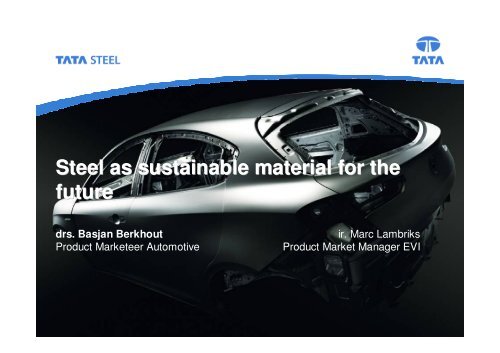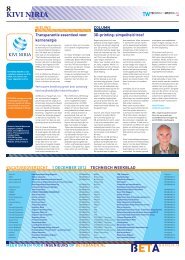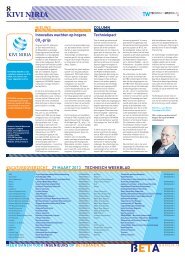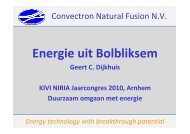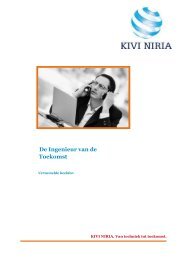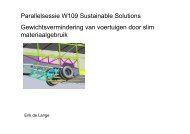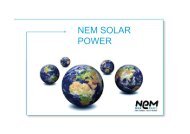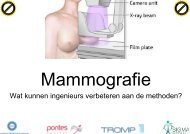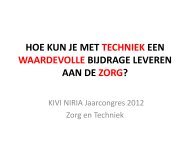Steel as sustainable material for the future - kivi niria
Steel as sustainable material for the future - kivi niria
Steel as sustainable material for the future - kivi niria
Create successful ePaper yourself
Turn your PDF publications into a flip-book with our unique Google optimized e-Paper software.
<strong>Steel</strong> <strong>as</strong> <strong>sustainable</strong> <strong>material</strong> <strong>for</strong> <strong>the</strong><br />
<strong>future</strong><br />
drs. B<strong>as</strong>jan Berkhout<br />
Product Marketeer Automotive<br />
ir. Marc Lambriks<br />
Product Market Manager EVI
Tata <strong>Steel</strong> Automotive<br />
Part of Tata <strong>Steel</strong> Europe<br />
• Crude steel capacity:<br />
• 18 mtpa<br />
• 2nd largest steel producer<br />
in Europe<br />
• 35,000 employees<br />
Automotive <strong>Steel</strong> Production<br />
• Flat products:<br />
• IJmuiden (The Ne<strong>the</strong>rlands)<br />
• Port Talbot, Llanwern (UK)<br />
• Long products :<br />
• Ro<strong>the</strong>rham, (UK)<br />
Downstream<br />
• Automotive <strong>Steel</strong> Service Centres<br />
• Gelsenkirchen (Ger)<br />
• Wednesfied (UK) incl. TWB<br />
• Paris (F)<br />
• Ma<strong>as</strong>tricht (NL)<br />
• Automotive Tubes<br />
• Zwijndrecht (NL)<br />
Ro<strong>the</strong>rham<br />
Engineering steels<br />
steel making<br />
Strip Products IJ<br />
Strip Products UK<br />
Engineering <strong>Steel</strong>s<br />
Tubes<br />
Automotive service cetres<br />
(incl. TWB –UK)<br />
IJmuiden<br />
<strong>Steel</strong> making<br />
Port Talbot<br />
<strong>Steel</strong> making<br />
Major manufacturing sites only
Tata <strong>Steel</strong> Automotive<br />
Automotive Products<br />
• Hot Rolled / Direct Rolled<br />
• Cold Rolled<br />
• HDG (GI and GA)<br />
• ERW Tube<br />
• Engineering <strong>Steel</strong>s<br />
Automotive Markets<br />
• Body in White<br />
• Ch<strong>as</strong>sis & suspension<br />
• Seating & interior<br />
• Powertrain<br />
Automotive Innovation<br />
• 5 global R&D facilities<br />
• 4 in Europe, leveraging in and out of India<br />
• Almost 800 researchers in Europe<br />
• Metallurgy, C<strong>as</strong>ting, Rolling & Finishing (NL)<br />
• Automotive Application Centre (NL)<br />
• Automotive engineering office (UK)<br />
Automotive customer b<strong>as</strong>e<br />
• Europe<br />
• NAFTA<br />
• India<br />
• Germany, Benelux<br />
• France, Italy<br />
• UK, Sweden,<br />
• Poland, Czech Rep. Hungary,<br />
Slovakia, Russia, Turkey<br />
• Great Lakes<br />
• Gulf area
Offering innovation & partnership<br />
Innovation in <strong>Steel</strong><br />
• Improved AHSS HyPer<strong>for</strong>m<br />
®<br />
Partner in Development<br />
• Material data<br />
®<br />
Partner in Production<br />
• Forming<br />
®<br />
• New alloying Concepts HSD<br />
• Material modelling<br />
• Stamping<br />
• Hydro<strong>for</strong>ming<br />
®<br />
• Innovative Coatings MagiZinc Auto<br />
• Simulation techniques<br />
• Welding<br />
• Spotwelding<br />
• Improved Processing ZnX<br />
®<br />
<strong>for</strong> PHS<br />
• Deployment & EVI<br />
• L<strong>as</strong>erwelding<br />
• Surface<br />
• Tribology<br />
• LCA<br />
• Corrossion
<strong>Steel</strong> – <strong>the</strong> <strong>sustainable</strong> <strong>material</strong>
<strong>Steel</strong> – A Unique Material<br />
The fundamental <strong>material</strong> characteristics of steel provide a<br />
unique contribution to <strong>sustainable</strong> development<br />
True Recyclability<br />
Diversity<br />
in Use<br />
Enhancing<br />
Sustainability<br />
Per<strong>for</strong>mance<br />
of Products
<strong>Steel</strong> – Truly Recyclable<br />
Once steel is made it enters <strong>the</strong> world stock of steel. It may stay <strong>the</strong>re <strong>for</strong> 1<br />
month or 100 years, but it will eventually join <strong>the</strong> true recycling loop
Sustainability of steel<br />
<strong>Steel</strong> industry strives <strong>for</strong> continuous improvement of <strong>the</strong>ir environmental<br />
per<strong>for</strong>mance and sustainability<br />
• <strong>Steel</strong> is 100 % recyclable<br />
• New steel qualities improve sustainability of our<br />
consumers products<br />
• <strong>Steel</strong> industry is committed to ongoing energy saving and<br />
reduction of CO 2 emission<br />
• <strong>Steel</strong> accounts <strong>for</strong> 5 % of man-made CO 2
The ULCOS project<br />
Objective:<br />
50% reduction in CO 2<br />
emissions per ton of steel from iron ore b<strong>as</strong>ed steel<br />
production by 2050<br />
• Globally <strong>the</strong> largest <strong>Steel</strong> Industry project on Climate Change<br />
• Core partners: ArcelorMittal, Tata <strong>Steel</strong>, ThyssenKrupp, Ilva, Voestalpine, LKAB,<br />
Dillingen/Saarstahl, SSAB, Rautaruukki<br />
• Co-partners: over 40 Institutes, Universities, Engineering companies, etc<br />
• Budget: 70 M€<br />
• Duration ph<strong>as</strong>e I: 2004 - 2010
The ULCOS project<br />
2004 ULCOS - I Project 2010 ULCOS - II Project 2018<br />
CO 2 en<br />
sustainability<br />
modelling<br />
Inventory<br />
process routes<br />
4 processes selected<br />
Top G<strong>as</strong> recycling BF<br />
HIsarna<br />
Selection<br />
G<strong>as</strong> b<strong>as</strong>ed reduction<br />
Electrolysis of iron ore
HIsarna technology<br />
Bl<strong>as</strong>t furnace<br />
sinter<br />
Iron ore<br />
coke<br />
Liquid iron<br />
coal
HIsarna technology<br />
Bl<strong>as</strong>t furnace<br />
sinter<br />
Iron ore<br />
coke<br />
coal<br />
Direct use of coal and ore<br />
No coking and agglomeration<br />
Liquid iron
Sustainability <strong>for</strong> <strong>the</strong> automotive<br />
market
The automotive dilemma impacts <strong>the</strong> <strong>material</strong> choice<br />
Consumer<br />
Legislative<br />
• Costs (fuel efficiency, insurance,<br />
purch<strong>as</strong>e, servicing)<br />
• Per<strong>for</strong>mance (handling,<br />
acceleration, braking, NVH,<br />
durability)<br />
• Vehicle appearance (styling, brand,<br />
perceived quality, interior space,<br />
storage, differentiation)<br />
• “lifestyle” choice leading to high<br />
numbers of cl<strong>as</strong>s variants<br />
green<br />
costs<br />
safety<br />
• European CO2 emission targets<br />
– 120g per km 2012<br />
– 95g per km 2020<br />
• Frontal, side and rear impact safety<br />
standards (Europe and US Federal)<br />
• Shift towards maintaining self<br />
protection whilst significantly<br />
improving partner protection<br />
(pedestrian & o<strong>the</strong>r vehicles)<br />
• Public domain cr<strong>as</strong>h per<strong>for</strong>mance<br />
ratings published by EURO-NCAP<br />
Economics<br />
• Material cost (steel versus aluminium)<br />
• Supply b<strong>as</strong>ed<br />
• Production knowledge & capability<br />
• Plat<strong>for</strong>m strategy<br />
• Investment in existing <strong>as</strong>sembly process<br />
Affects or is affected by<br />
<strong>material</strong> choice
So it is all about sustainability!<br />
Af<strong>for</strong>dability<br />
Clean transport <strong>for</strong> all<br />
PROFIT<br />
Safe transport <strong>for</strong> all<br />
PLANET<br />
PEOPLE<br />
LCA<br />
Safety<br />
Efficient design <strong>for</strong> safety<br />
The goal of sustainability <strong>for</strong> <strong>the</strong> automotive sector is to provide<br />
safe, clean and efficient transport, accessible to all
Af<strong>for</strong>dability<br />
1,674%<br />
112,9<br />
545%<br />
b<strong>as</strong>ed on a B-Pillar<br />
blank size 1400*600<br />
171%<br />
100%<br />
114%<br />
49,9<br />
56,5<br />
6,5<br />
16,5<br />
Material cost<br />
9,4<br />
Process cost<br />
3,5<br />
3,6<br />
O<strong>the</strong>r<br />
0,2 0,5<br />
1,5<br />
0,2 0,5<br />
1,5<br />
0,7<br />
<strong>Steel</strong> (cold)<br />
<strong>Steel</strong> (hot)<br />
Aluminium<br />
(cold / sheet)<br />
Magnesium<br />
(hot / sheet)<br />
CFRP
Af<strong>for</strong>dability<br />
The cost of CO2 reduction<br />
Technology CO2 saving* cost/vehicle Cost efficiency<br />
% € €/%<br />
Gearing/ecu optimise 6 10 1.6<br />
Low rolling resistance tyres 5 40 8<br />
Aerodynamic optimise 2 50 25<br />
Low friction lubricants 0.7 30 40<br />
Dual circuit cooling 0.5 25 50<br />
Regenerative alternator 0.5 35 70<br />
Aero design (10% lower Cd) 4 360 90<br />
Stop/start (micro hybrid) 2.5 250 100<br />
Heat storage system 0.5 60 120<br />
Electric water pump 0.5 80 160<br />
Mild hybrid (diesel) 10 2000 200<br />
Hydrogen ICE vehicle 100 20000 200<br />
Automated 6 speed manual 4 1000 250<br />
Full hybrid (e.g. Prius) 22 6000 270<br />
Aluminium bonnet 0.25 75 300<br />
Hydrogen FC vehicle 100 50000 500<br />
Aluminium BIW/closures 2 2000 1000<br />
Super lightweight vehicle 4 5000 1250<br />
* tank to wheel<br />
Source: Tata <strong>Steel</strong>, presented at IOM3 Warwick University Cost of Technology conference, July 2009
Improvements in safety<br />
Source: ika (2009) / EuroNCAP<br />
Incre<strong>as</strong>ed use of AHSS / UHSS<br />
• Incre<strong>as</strong>ed Safety<br />
• …but incre<strong>as</strong>ed vehicle m<strong>as</strong>s
Improvements in safety<br />
Volvo 940 – 1990/1998 – 1486kg<br />
Renault Modus – 2004/2008 – 1135kg<br />
Offset frontal cr<strong>as</strong>h<br />
Effect of advanced high strength<br />
steels offsets <strong>the</strong> difference in m<strong>as</strong>s.
It is not only about use ph<strong>as</strong>e emissions<br />
From: FSV Ph<strong>as</strong>e 1 report<br />
Source:
Importance of Life Cycle Assessment<br />
Material production greenhouse g<strong>as</strong> (GHG) emissions:<br />
GHG from Production (in kg CO 2 eq/kg of <strong>material</strong>)<br />
<strong>Steel</strong><br />
AHSS<br />
Aluminium<br />
Magnesium<br />
(electrolysis)<br />
Magnesium<br />
(pigeon)<br />
Carbon FRP<br />
2.3 – 2.7<br />
2.3 – 2.7<br />
13.9 – 15.5<br />
18 – 24.8<br />
21 – 23<br />
Current Average<br />
GHG Emissions<br />
Primary Production<br />
40 – 45<br />
Source:
Importance of Life Cycle Assessment<br />
Effect of powertrain and fuel efficiency improvements<br />
35,000<br />
30,000<br />
25,000<br />
20,000<br />
15,000<br />
10,000<br />
5,000<br />
0<br />
9% 10% 12% 13% 18%<br />
Source: UCSB Model<br />
22<br />
Source:
Importance of Life Cycle Assessment<br />
Source:
Sustainability & Life Cycle Assessment (LCA)<br />
Cradle-to-gate analysis of Magizinc<br />
Lower coating weight outweighs incre<strong>as</strong>ed impact<br />
of magnesium <strong>for</strong> coating weight reductions >30%<br />
Incre<strong>as</strong>ed life-span not considered in this study<br />
Reduction in GWP<br />
e.g. 140 g/m 2 HDG replaced<br />
by 70 g/m 2 MagiZinc<br />
Reduction in coating weight (%)<br />
LCA of Al-intensive & AHSS-intensive car<br />
Life-cycle impact of AHSS lower than aluminium<br />
LCA CO2 emissions (tonnes)<br />
35<br />
34<br />
33<br />
32<br />
31<br />
30<br />
Material<br />
Use-ph<strong>as</strong>e<br />
Mild steel AHSS Aluminium<br />
LCA at Tata <strong>Steel</strong><br />
•World <strong>Steel</strong><br />
Association<br />
LCA leadership<br />
award<br />
•Tata Innovista<br />
award
An example of smart <strong>material</strong> use
Facts and goals of <strong>the</strong> study<br />
• Facts<br />
• FSV is <strong>the</strong> successor of <strong>the</strong> recognized lightweight<br />
studies<br />
ULSAB 1998 and ULSAB-AVC 2001<br />
• Electrical vehicles are currently more demanding<br />
regarding weight saving so <strong>the</strong>y are more<br />
challenging to prove that steel is <strong>the</strong> best choice<br />
• Goals<br />
• Development of a smart lightweight steel BIW <strong>for</strong> an<br />
electrical vehicle (and 3 derivates) projected in 2020<br />
at large volume (100.000 p.a.)<br />
• Demonstration of latest steel grades and steel part<br />
manufacturing technologies<br />
• Development of <strong>sustainable</strong> and cost-effective<br />
solutions<br />
Timing: 2008 – 2011
Nature’s Way to Mobility<br />
• State-of-<strong>the</strong>-<strong>future</strong> development process<br />
• 188 kg body structure m<strong>as</strong>s - 35% m<strong>as</strong>s reduction<br />
• 97% use of HSS and AHSS<br />
• Nearly 50% GigaP<strong>as</strong>cal steels<br />
• Enables 5-star safety ratings<br />
• Nearly 70%Total Lifetime Emissions Reduction<br />
• M<strong>as</strong>s savings at no cost penalty<br />
http://www.<strong>future</strong>steelvehicle.org
Achievements<br />
Roll<strong>for</strong>ming<br />
Foreseen <strong>material</strong> mix<br />
10%<br />
Hot Stamping LWB<br />
9%<br />
Hot Stamping 2%<br />
41%<br />
Stamping<br />
Stamping LWB/TRB<br />
38%<br />
• 97% HSS<br />
• 50% UHSS<br />
• Stamping, hotstamping and<br />
roll<strong>for</strong>ming are main manufacturing<br />
technologies
Achievements<br />
No Cost Penalty<br />
Cost<br />
(US$)<br />
Body Structure Manufacturing Costs $775<br />
Body Structure Assembly Costs $340<br />
Total Body Structure Manufacturing & Assembly $1,115<br />
29
Achievements<br />
Enables 5-Star Safety Rating<br />
CAE Analysis<br />
Analysis Target FSV-1 Results<br />
Torsion Stiffness (kN-m/deg)<br />
≈20.0 19.604<br />
Bending Stiffness (N/mm) 12.0 15.552<br />
Global Modes - Torsion<br />
54.84<br />
>40 Hz (separated by 3 Hz)<br />
Global Modes - Vertical Bending 60.6<br />
US NCAP<br />
Euro NCAP<br />
Peak pulse < 40 g, foot well intrusion < 100 mm<br />
Peak pulse < 40 g, foot well intrusion < 150 mm<br />
Peak pulse 39.7 g, foot well intrusion 90.0 mm<br />
(average)<br />
Peak pulse 39.2 g, foot well intrusion 113.0<br />
mm (average)<br />
IIHS Side Impact B-Pillar intrusion with respect to driver seat centerline > 125 mm 134mm<br />
US SINCAP Side Impact B-Pillar intrusion with respect to driver seat centerline > 125 mm 215 mm<br />
FMVSS 301 Rear Impact<br />
ECE R32<br />
FMVSS 214 Pole Impact<br />
Euro NCAP Pole Impact<br />
FMVSS 216a and IIHS Roof<br />
RCAR/IIHS Low Speed Impact<br />
Battery remains protected and should not contact o<strong>the</strong>r parts,<br />
after <strong>the</strong> cr<strong>as</strong>h<br />
Door inner intrusion with respect to driver seat centerline ≥125<br />
mm<br />
Driver & p<strong>as</strong>senger side roof structure sustain load > 28.2 kN<br />
within plate movement of 127mm (FMVSS 216a), > 37.5 kN<br />
(IIHS)<br />
Damage is limited to <strong>the</strong> bumper and cr<strong>as</strong>h box<br />
Battery is protected and no contact with o<strong>the</strong>r<br />
parts, after cr<strong>as</strong>h<br />
159 mm<br />
169 mm<br />
Sustains load = 45 kN <strong>for</strong> driver side, = 43 kN<br />
<strong>for</strong> p<strong>as</strong>senger side<br />
No damage in components o<strong>the</strong>r than <strong>the</strong><br />
bumper and cr<strong>as</strong>hbox
Achievements<br />
Manufacturing fe<strong>as</strong>ibility<br />
Two-Piece LWB<br />
Four-Piece LWB<br />
DP600 1.25 mm<br />
BH220<br />
0.6 mm<br />
DP600 0.8 mm<br />
BH220<br />
0.6 mm<br />
DP1000 1.0 mm<br />
DP600 0.8 mm<br />
Options<br />
M<strong>as</strong>s<br />
Cost per Side<br />
(kg)<br />
(US$)<br />
Body Side Outer, Two-Piece LWB 11.6 $39<br />
Body Side Outer, Four-Piece LWB 13.9 $61
Achievements<br />
Manufacturing fe<strong>as</strong>ibility<br />
L<strong>as</strong>er Welds<br />
Spot Weld Spacing<br />
32 Adhesives
Achievements<br />
Reduces Life Cycle Emissions<br />
Emissions at<br />
<strong>material</strong><br />
production<br />
10% CO 2 e<br />
reduction<br />
2603<br />
2337<br />
ICE-g 2 BEV 1<br />
Global Warming Potential in kgCO 2 e<br />
12000<br />
Material<br />
Use<br />
Ph<strong>as</strong>e<br />
Ph<strong>as</strong>e<br />
10000<br />
8000<br />
6000<br />
4000<br />
2000<br />
0<br />
G<strong>as</strong>oline<br />
vehicle<br />
Battery<br />
electric<br />
vehicle<br />
Data source:<br />
FSV WorldAuto<strong>Steel</strong><br />
15 kWh/100km<br />
(EU-Grid 3 )<br />
8.3 kWh/100km<br />
(EU-Grid 3 )<br />
1 Future<strong>Steel</strong>Vehicle battery electric vehicle; 958kg curb<br />
weight; 188kg body in white; 8.3kWh/100km; 90% charging<br />
efficiency; 2 Polo-size internal combustion engine vehicle;<br />
1067kg curb weight; 231kg body in white; 5.7L/100km;<br />
2.865kgCO 2 e/L g<strong>as</strong>oline; 3 520 gCO 2 e/kWh<br />
0 10000 20000 30000 40000 50000<br />
Driving Distance in kilometer<br />
up to<br />
200000 km<br />
Emissions at<br />
vehicle use<br />
32655<br />
ICE-g<br />
<strong>Steel</strong> combined with BEV reduces CO 2 e in all ph<strong>as</strong>es of vehicle’s<br />
lifecycle<br />
40-70% CO 2 e<br />
reduction<br />
17344<br />
BEV<br />
15 kWh<br />
/100km<br />
9597<br />
BEV<br />
8.3 kWh<br />
/100km
Results at a glance<br />
lightweight<br />
Body in white weight: 188kg<br />
<strong>sustainable</strong><br />
innovative<br />
safe<br />
af<strong>for</strong>dable<br />
High Reduction of CO 2<br />
-Emissions<br />
• 10% <strong>material</strong> production<br />
• Significant reduction due to electric drive<br />
100 % recycling of <strong>the</strong> car body possible<br />
Realistic use of AHSS and UHSS<br />
97 % use of HSS and UHSS, 50 % GigaP<strong>as</strong>cal-steels<br />
State-of-<strong>the</strong>-art development process<br />
5 star cr<strong>as</strong>h rating possible<br />
Cost-effective reduction of weight and emission
Helping achieve sustainability in<br />
transport
Tata <strong>Steel</strong> automotive products<br />
• Advanced high strength steels: DP600, DP800,<br />
DP800HyPer<strong>for</strong>m, CP800<br />
• For cr<strong>as</strong>h relevant parts and <strong>the</strong> p<strong>as</strong>senger cell<br />
─ Downgauging <strong>for</strong> lightweighting or incre<strong>as</strong>ed safety by<br />
higher strength <strong>material</strong><br />
─ Less <strong>material</strong>, lower weight, lower tailpipe and LCA<br />
emissions, safe<br />
─ DP800HyPer<strong>for</strong>m enabling a gauge reduction of 10% over<br />
DP600 or strength incre<strong>as</strong>e over complex shaped DP600<br />
parts.<br />
• Engineered <strong>for</strong> improved behaviour during pressing<br />
─ Lower yield loss, better <strong>material</strong> efficiency<br />
• Complex Ph<strong>as</strong>e 800 enables simple sections to be<br />
<strong>for</strong>med with lower scrap by bending or roll<strong>for</strong>ming<br />
─ Improved <strong>material</strong> efficiency<br />
• Ultra high strength steels: DP1000, CP1000<br />
─ Enabling fur<strong>the</strong>r downgauging or strength incre<strong>as</strong>e
Tata <strong>Steel</strong> automotive products<br />
• New coating MagiZinc:<br />
• Zinc/magnesium/aluminium coating with up to 4x corrosion resistance of<br />
conventional HDG<br />
─ Enables use of thinner zinc coatings <strong>for</strong> equivalent per<strong>for</strong>mance<br />
─ Less <strong>material</strong> use, m<strong>as</strong>s reduction, lower LCA impacts<br />
─ Improved overall durability<br />
─ Reduced press-shop maintenance, improved pressing behaviour<br />
─ Less <strong>material</strong> w<strong>as</strong>tage<br />
• Aurora ® Online: datab<strong>as</strong>e<br />
• The Aurora datab<strong>as</strong>e <strong>as</strong>sists our customers during design & development by<br />
providing <strong>material</strong> data sheets to better predict <strong>the</strong> per<strong>for</strong>mance of parts or subsystems<br />
─ Enables optimised design <strong>for</strong> per<strong>for</strong>mance and weight<br />
• Development: fur<strong>the</strong>r lightweigting potential<br />
• Our steel developments are driven by allowing <strong>for</strong> even fur<strong>the</strong>r light weighting<br />
potential by innovative steel and coating concepts, combined with <strong>material</strong> efficiency<br />
through improved manufacturability
Thank you <strong>for</strong> your attention


